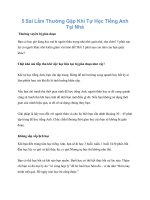Tài liệu tiếng Anh thương mại quản lý Chapter 14 Price and cost analysis
Bạn đang xem bản rút gọn của tài liệu. Xem và tải ngay bản đầy đủ của tài liệu tại đây (1.03 MB, 58 trang )
Chapter 14
Price and Cost
Analysis
14-1
Key Concepts
•
General Economic Considerations
»
Conditions Of Competition
»
Variable-Margin Pricing
»
Product Differentiation
»
Six Categories Of Cost
»
Regulation by Competition
14-2
Key Concepts
•
Price Analysis
»
Competitive Price Proposals
»
Regulated, Catalog, and Market Prices
»
Internet/e-Procurement
»
Historical Prices
»
Independent Cost Estimates
14-3
Key Concepts
•
Cost Analysis
»
Cost Analysis Defined
»
Capabilities of Management
»
Efficiency of Labor
»
Amount and Quality of Subcontracting
»
Plant Capacity
•
Sources of Cost Data
»
Potential Suppliers
»
Supply Partners
»
Cost Models
14-4
Key Concepts
•
Direct Costs
»
Direct Labor
»
Direct Materials
•
Tooling Costs
•
Learning Curves
»
Cumulative Curve and the Unit Curve
»
Target Cost Estimation
14-5
Key Concepts
•
Indirect Costs
»
Engineering Overhead
»
Materials Overhead
»
Manufacturing Overhead
»
General And Administrative
»
Selling
»
Recovering Indirect Costs
•
Activity-Based Costing
•
Target Costing
•
Profit
14-6
Introduction
•
Obtaining materials at the right price can
be a firm’s success or failure
•
Price or acquisition cost, is largest
component of total cost.
•
Right price, a fair and reasonable price to
both the buyer and the seller
•
no magic formula for calculating
•
The right price is not equal for all
suppliers
14-7
General Economic Considerations
•
Conditions Of Competition
•
Variable-Margin Pricing
•
Product Differentiation
•
Six Categories Of Cost
•
Regulation by Competition
14-8
Conditions of Competition
•
Three fundamental types of competition
exist:
»
Pure Competition
–
Supply and demand determines prices
»
Imperfect Competition
–
Monopolistic Competition
–
Oligopoly
»
Monopoly
–
One seller controls entire supply
14-9
Conditions of Competition
Pure
Competition
(price taker)
Monopoly
(price maker)
Area of Imperfect Competition
Monopolistic
Competition
Oligopoly
14-10
Variable-Margin Pricing
•
Frequent in suppliers that sell a line of
products
•
Pricing is based on whole line
•
Results in prices on some products that
are too high
•
Some prices are also artificially low
14-11
Product Differentiation
•
Undifferentiated: not distinguished by
specific differences
•
Differentiated: products appear different
from those of their competitors
14-12
Six Categories of Cost
•
Variable Manufacturing Costs
•
Fixed Manufacturing Costs
•
Semi Variable or Mixed Manufacturing
Costs
»
Examples: Maintenance, Utilities and Postage
•
Total Production Costs
»
Sum of variable, fixed and semi variable costs
•
Direct Costs
•
Indirect Costs (Overhead)
14-13
Cost, Volume, Profit Relationships
Figure 14-1
14-14
Regulation by Competition
•
The factors stemming from competition
determine the exact price each firm will
quote
•
That is, when faced with the realities of
competition, the price any specific firm
will quote will be governed largely by its
need for business and by what it thinks its
competitors will quote, not by costs or
profits
•
A firm tends to seek the highest price that
is compatible with its long-range goals
14-15
Long versus Short Run Considerations
•
In the long run, a firm must recover all
costs or go out of business
»
Plant and machinery must be maintained,
modernized, and replaced
•
In the short run, a firm should recover
variable costs and some portion of
overhead rather than undergo a significant
decline in business
»
Unless such additional business would affect
the pricing of current or future orders
14-16
Price Analysis
•
Competitive price proposals
•
Regulated, catalog, or market prices
•
Internet / e-procurement
•
Comparison with historical prices
•
Independent cost estimates
14-17
Competitive Price Proposals
•
At least two qualified sources have
responded
•
The proposals are responsive to the
buying firm’s requirements
•
The supplier competed independently for
the award
•
The supplier submitting the lowest offer
does not have an unfair advan-tage over
its competitors
•
The lowest evaluated price is reasonable
14-18
Regulated, Catalog, and Market Prices
•
Catalog Price
»
Price included in a catalog or list
»
Must be dated
»
Readily available for customer inspection
•
Market Price
»
Price equals interaction of many buyers and
sellers
»
Supply and demand establish prices
14-19
Internet / e-Procurement
•
Advanced communications using the
Internet allows supply management
personnel to view up-to-date pricing
•
Since the Internet does not have
geographical constraints, the information
is available worldwide
•
Among the capabilities the Internet
enables are:
»
Buying exchanges
»
Reverse auctions
»
Tailored global searches
14-20
Historical Prices
•
How have conditions changed?
•
Were there one-time engineering, setup, or
tooling charges in the original price?
•
What should be the effect of inflation or
deflation on the price?
•
Will the new procurement create a
situation in which the supplier should
enjoy the benefits of learning?
14-21
Independent Cost Estimates
•
Independent cost estimates may be used
as a basis for comparison of prices
•
This method is not used if other methods
are available
•
The price developed through an
independent cost estimate should be “fair
and reasonable”
14-22
Cost Analysis
•
Should be employed when:
»
Price analysis is impractical
»
Or price analysis does not allow a buyer to
reach the conclusion that a price is fair and
reasonable
•
Cost analysis is generally most useful
when purchasing nonstandard items and
services
14-23
Cost Analysis Defined
•
Cost analysis is a review and an
evaluation of actual or anticipated costs
»
It involves the application of experience,
knowledge, and judgment to data in an attempt
to project reasonable estimated contract costs
•
The purpose is to arrive at a price that is
fair and reasonable to both the buying and
selling firms
14-24
Elements Affecting Cost
•
Capabilities of management
•
Efficiency of labor
•
Amount and quality of subcontracting
•
Plant capacity and the continuity of output
14-25









